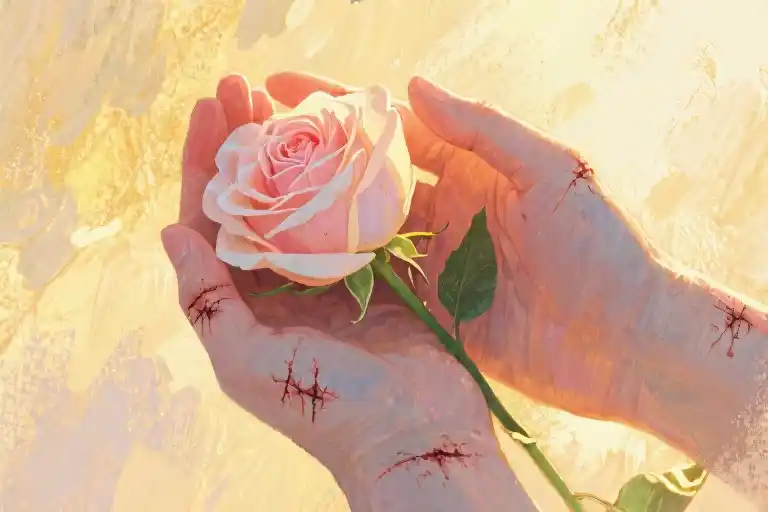The digital clock glows 2:17 AM in the darkness, but time stopped mattering hours ago. You know this ritual too well—the way your mind replays that conversation like a scratched vinyl record, each repetition deepening the groove of hurt. “Your biggest supporter is a stranger,” the words echo in the silence, “your biggest hater is someone you know.” The paradox hangs heavy in the air between the ceiling and your clenched jaw.
Why is it that the people we call home sometimes become the source of our deepest storms? The question isn’t rhetorical—it’s the splinter you can’t stop touching. That text message from your college roommate turned business partner, the family member who weaponized your secret against you, the friend who vanished when your depression became inconvenient. These aren’t paper cuts; they’re internal injuries that don’t show up on X-rays.
Neuroscience explains part of the sting—when betrayal comes from within our inner circle, it triggers primal alarm systems older than civilization itself. Our brains literally process social pain like physical wounds, activating the same neural pathways. But this knowledge doesn’t ease the 3 AM tremors when you remember how casually they broke what took years to build.
There’s a particular cruelty to intimate betrayal that strangers could never achieve. It’s not just the act itself, but the annihilation of shared history—every inside joke, every midnight confession, every “I’ll always have your back” now retroactively poisoned. You start conducting forensic examinations of your past, wondering which moments were genuine and which were landmines waiting to detonate.
Yet here’s the uncomfortable truth no one mentions: sometimes the healthiest response isn’t forgiveness or revenge, but simply letting the relationship fossilize. Not every fracture demands repair, especially when the other person keeps swinging the hammer. This isn’t bitterness—it’s the recognition that some connections cost more than they’re worth.
The real work begins when you stop waiting for an apology that will never come. Not because you don’t deserve it, but because their inability to offer one says everything about their limitations and nothing about your worth. This is where healing diverges from justice—you learn to parent yourself through the aftershocks, becoming both the wounded and the witness.
What no one prepares you for is how loneliness can become a kind of sanctuary. At first it feels like punishment, then gradually like protection, until one day you realize it’s morphed into something else entirely—a quiet space where your thoughts no longer get edited for someone else’s comfort. The walls you built to keep them out accidentally became the room where you finally heard yourself.
But human hearts aren’t meant to live in permanent lockdown. The ultimate rebellion isn’t sealing yourself off, but learning to trust again—not blindly, but with measured courage. To extend a hand even when it trembles, to love without guarantees, to risk new connections while honoring the scars of the old. This is the alchemy that turns betrayal into wisdom—not by forgetting the pain, but by refusing to let it dictate your capacity for joy.
The digital clock now reads 3:42 AM. Somewhere between then and now, you’ve stopped replaying their words and started hearing your own. This is how healing begins—not with dramatic revelations, but in these quiet midnight moments when you choose your own company over their ghost.
The Anatomy of Betrayal
It’s a peculiar cruelty of human relationships that the deepest wounds often come from those we’ve invited past our defenses. Studies show nearly 70% of emotional trauma originates within our inner circles – friends, partners, or family members within three degrees of intimacy. This statistical reality contradicts our instinctive fear of strangers, revealing an uncomfortable truth about where real vulnerability lies.
Consider two parallel scenarios: A cancer patient receives anonymous donations from online supporters who’ve never seen her face, while childhood friends gradually disappear from her hospital room, their last text messages reading “too busy this week.” Or the immigrant who finds genuine help from a neighbor met last month, while relatives back home whisper about her “abandoning tradition.” These aren’t exceptional cases – they’re patterns repeating in therapists’ offices and support groups worldwide.
What makes betrayal from intimates so devastating isn’t just the broken trust, but the shattered framework it leaves behind. When a stranger harms us, we can categorize the experience neatly. But when someone who’s seen us at our most unguarded turns that knowledge against us, it scrambles our entire emotional navigation system. Suddenly, memories become crime scenes – that inside joke you shared now feels like reconnaissance, those late-night confessions seem like tactical disclosures.
Neuroscience explains part of this phenomenon through what’s called the “social pain overlap theory.” Our brains process emotional betrayal similarly to physical pain, with fMRI scans showing identical activation patterns in the anterior cingulate cortex. But with intimate betrayals, there’s an added dimension – these experiences trigger what attachment theorists call “relational flashbacks,” where current wounds reopen every past abandonment. A friend’s casual dismissal might echo a parent’s neglect from decades prior, layering fresh hurt over never-healed scars.
The real danger lies in how these experiences distort our threat detection. Like immune systems overreacting after severe illness, we often start seeing betrayal where none exists, building fortresses against imagined invasions. I’ve watched brilliant women dissect every compliment for hidden barbs, kind men preemptively distance themselves to avoid potential hurt. This hypervigilance creates what psychologists term “phantom betrayal” – the anticipatory pain that often hurts more than the real thing.
Yet even knowing these mechanisms, the heart struggles with cognitive dissonance. How could the person who brought soup when you were sick later use your insecurities as ammunition? How does someone who cried with you over lost love eventually become the one taking it away? There’s no satisfying answer, only the slow acceptance that human connections contain multitudes – the same hands that build can demolish, often without conscious intent.
What survivors eventually recognize is this: The betrayal wasn’t about your worth, but their limitations. Some people can’t hold space for others’ pain without making it about themselves. Others mistake intimacy for ownership, loving only versions of you that fit their narratives. And a few simply lack the emotional tools to navigate complex relationships – not malicious, but dangerous nonetheless.
This understanding doesn’t immediately soothe the ache, but it begins untangling the knot of self-blame. The work isn’t in figuring out why they hurt you, but in learning how to stop hurting yourself with that question. As the poet Nayyirah Waheed wrote, “You do not have to be a victim to what has happened to you.” The anatomy of betrayal matters less than how we reassemble ourselves afterward.
The Science Behind Betrayal Wounds
The moment plays on repeat – their words, your reaction, the sinking feeling in your chest. Months later, your body still tenses when you hear a similar phrase or pass that coffee shop where it happened. This isn’t just emotional memory; it’s physiological engraving.
Our brains treat betrayal like physical threat. The amygdala, that almond-shaped alarm system, can’t distinguish between a knife and a broken promise. Both trigger the same fight-flight-freeze response, flooding your system with cortisol. That’s why certain memories still make your palms sweat years later – your nervous system marked them as survival threats.
The deeper the trust, the sharper the betrayal. Childhood attachment patterns wire our relational blueprints. If early caregivers were inconsistent or hurtful, your adult brain may overinterpret later betrayals as confirmation of an unspoken belief: I am unworthy of steady love. This creates neural pathways that expect disappointment, making fresh wounds feel like ancient history repeating.
Three physiological markers explain betrayal’s lasting impact:
- Epinephrine tagging – Stress hormones during traumatic events stamp memories with unnatural vividness. That’s why you remember the exact shade of their shirt during the painful conversation.
- Hippocampal interference – Chronic stress shrinks this memory-regulating region, making it harder to contextualize painful events as past rather than present danger.
- Mirror neuron confusion – These empathy circuits keep replaying the betrayer’s perspective, trapping you in mental loops of Why would they…?
The cruel irony? The people we love most hold the sharpest knives not because they’re malicious, but because they know where we keep our armor off. A stranger’s insult glances off; a loved one’s careless word slips between ribs.
Healing begins when we recognize these reactions as evolutionary wiring, not personal failure. Your pounding heart isn’t weakness – it’s a remarkably sensitive threat detection system that once kept ancestors alive. The work isn’t to dismantle this system, but to retrain its alert settings through:
- Somatic countermeasures – Slow exhales during flashbacks to signal safety
- Memory reconsolidation – Rewriting painful memories with new, empowering meanings
- Neural reparenting – Giving your younger self the secure attachment experiences it craved
This isn’t about erasing scars, but understanding their texture. Those neural pathways will always exist, but with time, they become like old hiking trails – visible, but no longer your only route through the emotional wilderness.
The Architecture of Soft Boundaries
Trust becomes architecture when betrayal teaches you to build. Not the fortress walls you see in storybooks – those are for wars and fairy tales. What we need are living structures, breathing membranes that filter without suffocating, that protect without imprisoning. I’ve learned to construct what therapists call ‘permeable boundaries’ – not iron gates, but something closer to a three-layer filtration system for the soul.
The Emotional Hourglass works on gravity’s patience. When someone shares their chaos with you, let it trickle through the narrow passage between bulbs. The upper chamber holds their unfiltered words, the lower chamber collects what actually deserves your attention. That middle passage? That’s where you install the questions: ‘Is this mine to carry?’ ‘Does this person have debris or diamonds to offer?’ The hourglass isn’t cruel – it simply acknowledges that not all emotional spills require your mop.
Time Locks revolutionized my relationships. Every connection gets its own temporal rhythm now. The colleague who drains me? Our coffees last precisely forty minutes. The childhood friend stuck in perpetual crisis? Our calls happen on the first Sunday, never on vulnerable weeknights. At first it felt calculating, until I realized: banks don’t apologize for vault timers, and your psyche shouldn’t either. What we’re really measuring isn’t minutes, but the half-life of our resilience.
Information Sieves might be the kindest innovation. They work like those colanders with adjustable holes – some relationships get fine mesh for delicate confidences, others the wide gaps for casual chatter. My sieve has categories:
- What I’ll share with anyone (my love for jasmine tea)
- What I reserve for tested allies (my hospital phobia)
- What belongs only to me (that third thing I’ll never name here)
The magic isn’t in the sorting, but in remembering you can change the settings mid-conversation. When my mother probes about my dating life, I’ve practiced saying: ‘That part of my garden isn’t open for tours today.’ Not hostile, just horticultural.
These structures aren’t about rejecting love, but about redesigning how it flows through you. Like a beach house built on hurricane coastlines – the walls have shutters that close when storms come, but the windows still face the ocean. Because after all this engineering, here’s the secret they don’t tell you in survival manuals: The safest boundary isn’t the one that keeps pain out completely, but the one that lets you feel it without being destroyed.
So when you reach that moment – when someone’s words press against your newly drawn lines – try this script I keep in my back pocket: ‘I want to be there for you, and I need to do it in a way that doesn’t leave me unable to show up for myself tomorrow.’ It’s not rejection. It’s the most loving form of self-defense – the kind that leaves everyone’s dignity intact.
The Alchemy of Unfinished Business
The letter sits unfinished in my desk drawer, the edges frayed from being folded and unfolded too many times. It holds all the words I wish I’d heard—words that will never come from the person who owes them to me. This is the paradox of unresolved hurt: we keep waiting for closure from those least capable of giving it, while the real healing begins when we become the authors of our own absolution.
Existential philosophers understood this dance with emptiness better than most. Sartre’s assertion that “existence precedes essence” takes on brutal clarity when applied to emotional wounds. The meaning of our pain isn’t found in the betrayal itself, but in what we choose to build from its rubble. I’ve spent nights parsing this truth like a difficult text—if someone’s cruelty doesn’t define them, why have I let it define me?
There’s a peculiar freedom in realizing some apologies live only in the conditional tense. The kind that begin with “if” and trail off into silence. These non-apologies have their own taxonomy: the deflection (“I didn’t know you’d take it that way”), the martyrdom (“I guess I’m just the villain now”), and most corrosive of all—the erasure, where the hurt is so thoroughly ignored you start questioning whether it happened at all.
Ritual becomes our counter-spell to this silence. The act of writing a letter you’ll never send isn’t about communication—it’s about exorcism. There’s neuroscience behind this: the physical act of handwriting engages the brain differently than typing, activating regions associated with emotional processing. When we burn these unsent words, we’re not performing drama—we’re creating somatic markers that tell our nervous system: this chapter is allowed to end.
I once believed forgiveness meant handing the offender a key to my peace. Now I understand it as returning their power to harm me—all of it, even the pieces they didn’t know they held—and locking the door behind them. This isn’t the forgiveness of turned cheeks and saintly smiles. It’s the gritty, unglamorous work of reclaiming real estate in your own mind.
The alchemy happens when we stop waiting for their transformation and begin our own. That crumpled letter in my drawer? I’ve come to see it not as unfinished business, but as a map showing where I no longer live. Some mornings, I take it out just to marvel at how foreign the handwriting looks—like it belongs to someone I used to be.
What we call “closure” is often just the moment we outgrow the need for external validation of our pain. The apology you’re waiting for wouldn’t fit the person you’ve become. And perhaps that’s the most merciful truth of all.”
The Trembling Hand Experiment
The most courageous act isn’t the grand gesture—it’s the slight tremor in your fingers as they reach across the chasm of old wounds. After betrayal rewires your nervous system, every attempt at connection feels like touching a hot stove. Yet here we are, practicing the delicate art of reaching anyway.
Safety first becomes our mantra. Before plunging into deep waters, we test the temperature with three subtle signals:
- The Wrist Pause
That space between handshakes and hugs holds magic. When meeting someone new, let your fingertips graze their inner wrist for half a second—long enough to sense micro-reactions, brief enough to retreat gracefully. The body doesn’t lie like words can. Notice if their pulse jumps toward you or pulls away. - The Song Exchange
Music bypasses the betrayed brain’s defense systems. Share one track that contains everything you can’t say yet—maybe Hozier’s Cherry Wine for quiet resilience or Brandi Carlile’s The Joke for reclaimed power. Their playlist response will reveal more than any conversation. - The Sunset Telegram
No words, just a photo of evening skies sent at golden hour. No demands for replies, just evidence that beauty still exists and you thought to share it. The colors say what your voice isn’t ready to: I still believe in light after darkness.
For 24 hours, document every micro-attempt at connection under #TremblingHandReach. Not the polished outcomes—just the raw attempts:
- The text you wrote and deleted three times before sending
- The coffee invitation you almost canceled
- The deep breath before saying that vulnerable thing
What we’re really tracking isn’t success rates, but the quiet revolution of showing up. Each tremor proves your capacity for trust wasn’t destroyed—just buried under protective layers. Like trees adding rings after storms, these small reaches become your growth records.
Some reaches will ache. Others might surprise you. All will matter. Because healing from betrayal isn’t about never feeling fear—it’s about letting your hands shake while they relearn how to hold and be held.
The Rose in Your Trembling Hand
The image stays with me – a hand holding a rose, fresh cuts visible across the palm, yet the grip remains steadfast. Not the white-knuckled clutch of desperation, but the gentle pressure of deliberate choice. This is where healing lives: in that impossible intersection of woundedness and willingness.
We’ve walked through the anatomy of betrayal together – how it carves deeper when the blade comes from familiar hands. We’ve examined how our nervous systems remember what our minds want to forget, and built flexible boundaries that allow air without abandoning armor. We’ve even created ceremonies for the apologies we’ll never receive. Now comes the quietest revolution – the decision to extend your hand again, knowing it might get cut, knowing you’ll survive if it does.
This isn’t about reckless vulnerability. The rose you hold has thorns of its own now – the wisdom of measured trust, the discernment you’ve earned through pain. Notice how differently you grip the stem compared to when you first reached out blindly. Your fingers know exactly where to avoid the sharpest points, applying just enough pressure to keep the flower upright without crushing its petals. This is the mastery that betrayal unknowingly taught you.
Some will misunderstand your caution as cynicism. They’ll accuse you of holding the rose too loosely, not realizing your light touch demonstrates more reverence than their romanticized death-grip ever could. True tenderness requires precision – the kind that comes from knowing exactly how much pressure makes a wound bloom versus how much makes it bleed.
The trembling you feel isn’t weakness leaving your body; it’s strength learning to breathe. Each slight shake contains entire histories – the friend who vanished when your depression returned, the partner who weaponized your insecurities, the family member who rewrote history to avoid accountability. Your muscles remember what your heart still struggles to articulate. Yet here you are, arm extended despite the tremor, because some part of you still believes in the scent of petals after rain.
What if we measured courage differently? Not by the absence of fear, but by the quality of your reach. There’s extraordinary honor in how you now offer connection – eyes open to both the rose’s beauty and its capacity to draw blood. This nuanced reaching changes everything. Where once you gave trust like a wide-flung door, now you offer it as a series of carefully placed stepping stones. Some will call this progress; others will call it damage. You know it simply as the truth written in your skin.
So when the night comes and you question whether to withdraw completely, ask yourself this: What version of you do you want to meet in the mirror tomorrow? The one who let pain dictate all future possibilities, or the one who carried both wisdom and wonder in the same hand? The choice to reach – however slightly, however shakily – is how we reclaim our narrative from those who mishandled it.
Your trembling doesn’t disqualify your strength; it authenticates it. Only those who have known the weight of betrayal can understand the gravity of choosing to trust again. That shaking is the visible manifestation of your whole history wrestling with your future hopes – and still deciding the latter matters more.
The world will try to measure your healing in absolutes: Have you forgiven? Have you forgotten? Have you become invulnerable? But real recovery lives in the subtleties: The deep breath before answering a vulnerable question. The pause before attaching meaning to someone’s late reply. The willingness to enjoy a moment without demanding guarantees about the next. These are the quiet victories no one applauds but change everything.
So here’s my question, the one that matters more than all the apologies you’ll never receive: When you look at that rose in your wounded hand – when you feel the old fears rise like ghosts and the new wisdom settle like morning dew – can you recognize the extraordinary ordinary miracle of your own continued reaching?
That trembling isn’t your weakness shaking. It’s your courage, vibrating at a frequency only broken-open hearts can hear.





